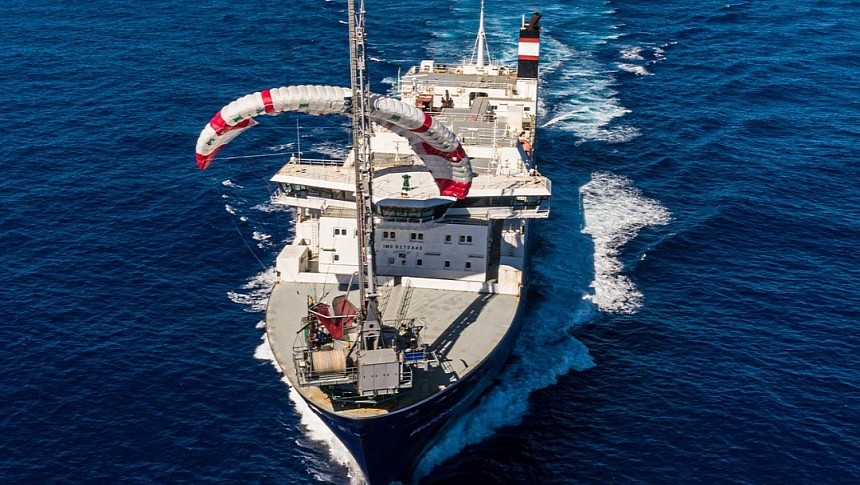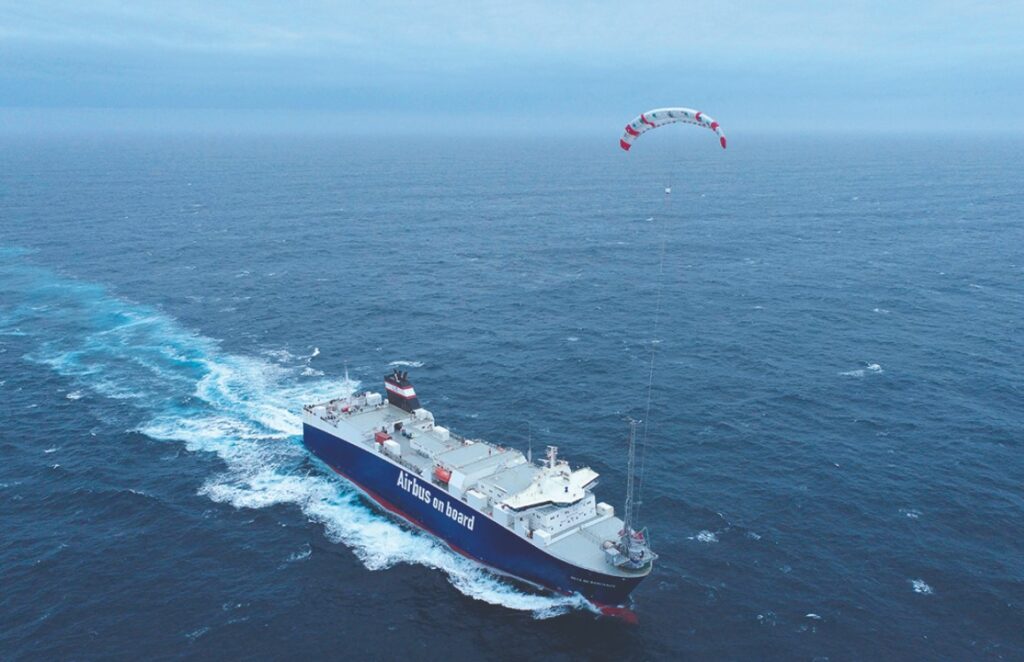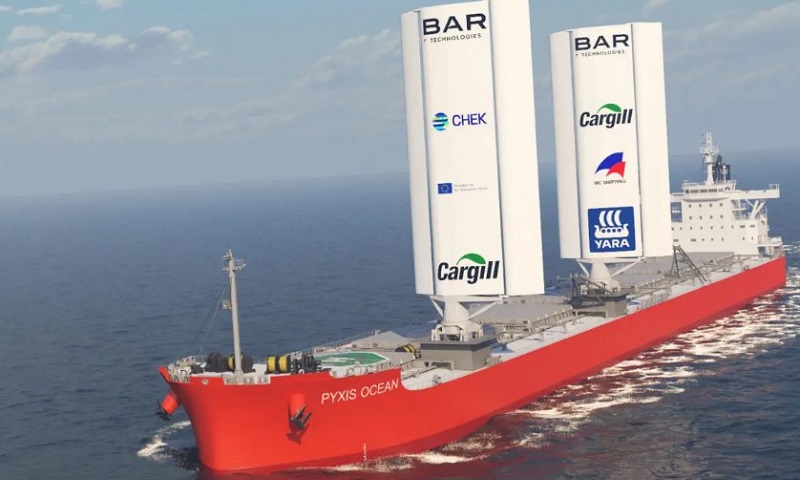New Mars Forums
You are not logged in.
- Topics: Active | Unanswered
Announcement
#1 2024-02-19 04:57:38
- Terraformer
- Member
- From: The Fortunate Isles
- Registered: 2007-08-27
- Posts: 3,988
- Website
Carbon-Free Propulsion Using Articulated Tug and Barge Technology
Carbon-Free Propulsion Using Articulated Tug and Barge Technology -- Maritime Executive
A tug of 3,500 to 4,000-horsepower is able to propel a barge tow of 4-barge widths by 10-barge lengths.
Railways moving the same tonnage and or volume as 40-barges would require groups of locomotives generating 30,000 to 40,000-horsepower to pull several trains.
We're not the only ones thinking along these lines:
Recent advances in liquid air energy storage could form the basis of tug propulsion. The tug could operate on heat-of-fusion stored thermal energy and recharge at coastal nuclear power stations.
A wide range of technologies have future potential to provide carbon-free propulsion for maritime vessels and might include:
- Liquefied Air: Initiatives are underway in England to develop grid-scale energy storage using super-cooled liquefied atmospheric air that has a density of over 80% that of liquid water. It has been successfully tested as propulsion in a small car and has potential to being adapted for ship propulsion where a geared turbine or positive-displacement rotary engine would drive a propeller. The combination of liquefied air stored inside well insulated containers and a source of stored thermal energy aboard a mega-size tug could theoretically propel a barge for distances of 600 to 1,000 n. m.
- Iron-Air Battery: The iron air battery occupies the space of a standard size shipping container (40-feet length). Small-scale testing indicated negligible deterioration of battery chemistry after 20,000-full depth drain cycles and is able to deliver steady output for a duration of up to 100-hours. An array of 2-levels of 8-wide by 4-lengthwise of iron-air battery containers (64) carried aboard super tug of 300-ft length by 70-ft width would deliver over 4,000-horsepower for 100-hours, making the technology suitable for tug-barge operation along inland waterways. Coastal operation and Great Lakes service would require larger versions of the tug.
- Stored Thermal Energy: Modern solar-thermal power stations continue to generate electric power after sunset, generating steam from thermal energy stored in mixtures of molten salt such as 80% lithium hydroxide and 20% lithium fluoride. There may be scope to modify coastal nuclear power stations to include a dock, where a tug may be moored to replenish its thermal energy supply. The tug would use a geared steam turbine or suitable positive-displacement rotary engine to provide propulsion while pushing and navigating barge trains along inland waterways or single barges in short-haul coastal service.
Presumably barges on canals and rivers will not have to deal with the sort of wave conditions faced by coasters? Maybe we could do far more articulation there then... Tom Pudding
Use what is abundant and build to last
Offline
Like button can go here
#2 2024-02-19 07:24:37
- tahanson43206
- Moderator
- Registered: 2018-04-27
- Posts: 23,665
Re: Carbon-Free Propulsion Using Articulated Tug and Barge Technology
This post is reserved for an index to posts that may be contributed by NewMars members...
Index:
Post by kbd512 with images of sail powered modern vessels, and details of tug propulsion and hull design for their mission.
https://newmars.com/forums/viewtopic.ph … 79#p234679
***
Best wishes for success with this interesting new topic....
This is the first time I've seen the idea of combining the thermal store and liquefied air in one transport system. This solves the problem of having to scavenge thermal energy from the atmosphere or from the water.
I'm hoping our members with mechanical system design skills will show how this concept could be implemented at various scales.
I remain interested in a small scale energy storage system able to deliver 20 amps at 120 VAC for an hour in a remote work setting.
Members of this forum have speculated about use of compressed air for this purpose, but so far all we have is hand waving.
Hand waving is good, but I'd like to see the speculation resolve to drawings that can be put into Real Universe use.
(th)
Offline
Like button can go here
#3 2025-09-24 06:19:34
- tahanson43206
- Moderator
- Registered: 2018-04-27
- Posts: 23,665
Re: Carbon-Free Propulsion Using Articulated Tug and Barge Technology
This topic is intended for Earth.
In another topic, SpaceNut introduced the idea of how to ship goods in space with fewer spacecraft designed for atmosphere travel.
Space barges would seem an attractive alternative for a great variety of goods that do not need special treatment in vacuum.
Space barges need space tugs, and GW Johnson has already described a variety of space tugs.
Carbon free propulsion is certainly an option for space tugs, although I suspect that the many advantages of carbon fuels for space applications will insure their use for some time to come.
A separate topic for space barges and the tugs to push them is an option.
If this topic is going to take off with an Earth focus, an entrepreneur needs to see a path to profitability. At present, the barge infrastructure appears to be well established using carbon fuels. Increased availability of nuclear electric power might lead toward profitability for non-carbon energy storage systems, such as the liquid air with which this topic opened.
(th)
Offline
Like button can go here
#4 2025-09-25 17:33:54
- Calliban
- Member
- From: Northern England, UK
- Registered: 2019-08-18
- Posts: 4,278
Re: Carbon-Free Propulsion Using Articulated Tug and Barge Technology
Interesting topic. As the study notes, there are a number of ways to power a tug. Liquid air is promissing, as the water surroundingbthe tug can provide a heat source. Stored thermal energy in a phase change material could work as well. In the case of liquid air, the heat pump producing the air could dump heat into a district heating system. Liquid air has the advantage of being storable in underground tanks. A well designed system could avoid the need for cryogenic pumps by allowing liquid air to be distributed by gravity. Seperating the air into LN2, LOX and noble gases, would allow other revenue streams. Air liquefaction also allows CO2 capture from the air.
"Plan and prepare for every possibility, and you will never act. It is nobler to have courage as we stumble into half the things we fear than to analyse every possible obstacle and begin nothing. Great things are achieved by embracing great dangers."
Offline
Like button can go here
#5 2025-10-03 23:35:48
- kbd512
- Administrator
- Registered: 2015-01-02
- Posts: 8,379
Re: Carbon-Free Propulsion Using Articulated Tug and Barge Technology
Island Victory is one of the most powerful tugboats in the world, with 42,880hp worth of installed engine power. The props on tugs like this are nothing too spectacular when it comes to propulsive efficiency, perhaps 65% efficient at converting shaft power into thrust. That's a necessary concession to high-thrust at low-rpm, frequently accomplished using ducted propellers that don't perform very well at higher speeds. The prop design can't and won't be optimally efficient at all speeds. Even variable-pitch props don't produce as much thrust at low speeds as ducted props, which is why tugs frequently use ducted props. You have to design to a given criteria set, same as an aircraft propeller. Efficiency will be very important for a tug using batteries, liquid air, or other forms of natural energy, all of which have far lower gravimetric and volumetric energy density than hydrocarbon fuels. Larger diameter props do help with that, but there will be draft limits, especially within inland waterways. The Sharrow prop design could help reduce diameter while maintaining thrust, without the use of a thrust-robbing duct at higher speeds. Large diameter props also cost a lot more, but so do Sharrow props. The hull forms used by modern tugs are already pretty close to ideal for their intended applications, although rudders are optimized to minimize thrust sapped from the prop(s). Perhaps the new weldable Mangalloy steel plate developed by the Japanese and South Koreans would allow liquid air to be carried within a "double hull", similar to LNG, at more reasonable material and fabrication cost, as compared to stainless, and with fewer corrosion / pitting issues, which is why no ocean-going ships use stainless hulls.
To a point, top speed is far less impressive for a tugboat than pure "pulling power" at speeds below 10 knots. However, the ability to tow ships in for repairs will likely be affected. For starters, you cannot sail at any speed you please, into or out-of a port facility, nor within the confines of restricted inland water ways. Power required also increases dramatically as speed increases, so travel at lower speeds is advantageous to total cost, provided that personnel and equipment costs don't exceed fuel costs, whatever said "fuel" happens to be. 4,000hp might be plenty for low speed travel, but it will affect the bollard pull of a tug. This implies more tugs, more powerful motors / engines, and/or shorter operating times at full power. That said, 10 knots was well above the speed at which we would approach congested ports aboard an aircraft carrier, which somewhat counter-intuitively, is now a much smaller ship than many of these new super-massive cargo and tanker ships requiring tugboat assistance to navigate from / to a pier.
If we're serious about using liquid air as a viable marine fuel, then we need to create ocean-going barges capable of station-keeping, operated along common shipping lanes, able to perform liquid air transfer to ships underway, to refuel cargo and tanker ships. The US Navy calls this "UNREP" (UNderway REPlenishment). Each ship in a battlegroup typically has an UNREP event scheduled once or twice per week. This adds cost, but allows for continuous semi-autonomous operation at sea, without the need to visit a port. The barges will likely use some form of wind and/or solar power to suck in, filter, compress, and liquefy the air. As ships pass through, they will come alongside the barge, take on a fresh load of liquid air to continue their intercontinental transits.
Large scale liquid air energy density is around 125Wh/kg of usable energy, which could be doubled or perhaps tripled with an onboard load of molten salt. Diesel fuel burned in a very large low-speed marine engines, which are about 50% thermally efficient, provides 6,250Wh/kg, so 50X greater usable energy density. I've seen Aluminum-air batteries with energy density figures quoted at up to 2,500Wh/kg. Lithium-ion batteries are around 300Wh/kg at the cell level, but not at the pack level, and some packaging is still required to inhibit the worst effects of a thermal runaway and to move large strings of cells as a singular unit. Iron-air and modern Lead-acid batteries have very similar energy density. You can't make a ship's energy supply 2.5X (Aluminum-air batteries) to 50X (liquid air) heavier and still expect the ship to be roughly the same size or to perform similarly. The "super-sized" tugs referenced in the article would quite literally be the same size as WWII era battleships, meaning 25,000t to 40,000t, not tugboats. Succinctly, no amount of efficiency improvement can overcome energy deficits of that magnitude. Diesel engines and diesel fuels remain the workhorses of the entire modern world for a reason. Thus far, no other energy generation and storage technology can match the combination of characteristics they provide. The end result will be more costly ships with less range and cruising speed capability, which implies a requirement for many more ships and the support infrastructure to complete the same transportation and maneuvering tasks.
The only kinds of emission-free ships capable of covering economically-useful distances are, in point of fact, ye olde wind-powered sailing vessels. The modern "take" on classical sailing ships involves using a 1,000m^2 technical fabric "kite" tethered to the bow of the ship and flown at an altitude of 300m, using an automated computer control system to model wind and ship behavior. This provides roughly 100,000kg-f of propulsive power, using average wind speeds. It does not require tall heavy masts to hold sails. A pay-in / pay-out device similar to a capstan is used to control said device, using deck space that is typically clear / available on most cargo and tanker ships. To deliver 100% of the force required to achieve top speed using its diesel engine, the Emma Maersk container ship, a very large vessel, even by today's standards, requires a bit over 7.5MN of force to sail at 24.5kts, so the sailing kite's surface area becomes 7,648m^2. The giant diesel engine and fuel cold be replaced by a nominal quantity of liquid air for electrical power generation and maneuvering near ports.
SeaWings "Kite" Deployment:
Flying this "kite" at altitude permits access to higher average wind velocity:
Bar Technologies uses both Aluminum 37.5mH (750m^2 / 200t per sail) and composite 20mH to 24mH 3-element sails (<30t per sail), which achieve greater lift than single element rigid sails using a fowler flap design similar to that used by commercial airliners:
Offline
Like button can go here
#6 2025-10-06 06:08:29
- Calliban
- Member
- From: Northern England, UK
- Registered: 2019-08-18
- Posts: 4,278
Re: Carbon-Free Propulsion Using Articulated Tug and Barge Technology
The kite sail concept looks very promissing. This is something that can save fuel when the wind speed and wind direction is sufficient and be wound in and packed away when not needed. And it doesn't eat into hull volume and cargo space. Definitely something that deserves wider application.
Liquid air could be deployed as part of a hybrid propulsion system. The waste heat produced by the diesel engines is high quality heat at a temperature of up to 500°C. It would allow for efficient energy recovery from the liquid air. But on the plus side, the ship still functions on diesel if liquid air isn't available. So again, this is something that can save fuel over the lifetime of the ship. In the medium term, we don't necessarily need to phase out diesel altogether. If we can use it more efficiently then we extend the lifetime of the resource base. But things that add a lot of additional hardware cost only make sense if diesel is physically unavailable.
The low energy density of liquid air would appear to be less of a problem for inland or coastal freight transport. Maybe rail could make use of this tech as well.
Last edited by Calliban (2025-10-06 06:14:26)
"Plan and prepare for every possibility, and you will never act. It is nobler to have courage as we stumble into half the things we fear than to analyse every possible obstacle and begin nothing. Great things are achieved by embracing great dangers."
Offline
Like button can go here